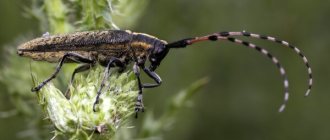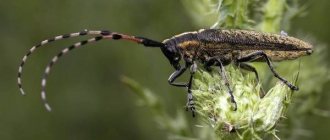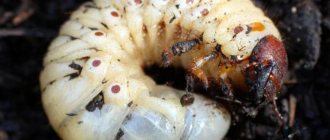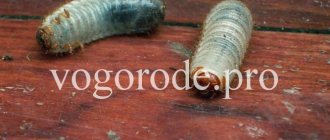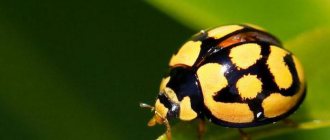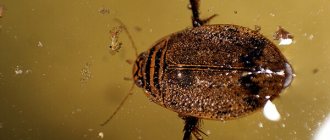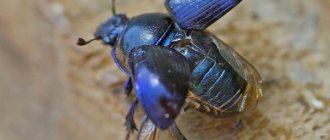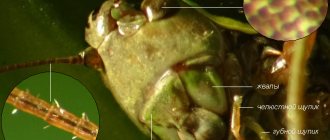- Wild animals
- >>
- Insects
A striking representative of the order Coleoptera is the relict woodcutter . This insect has impressive dimensions, long mustaches and many other memorable external characteristics. The animal received its name in connection with its behavioral and physical preferences: a tree is a home for woodcutters and serves as food for them. Other features of this insect are described in this publication.
Origin of the species and description
Photo: Relic woodcutter
Relic woodcutter has many other names. It is often called the relict or Ussuri longhorned beetle, the Ussuri woodcutter. In Latin, the animal is called Callipogon relictus. Lumberjacks belong to the longhorned beetle family, a subfamily of prionines. They are prominent representatives of the numerous order of Coleoptera. In Eurasia, this insect is recognized as the largest beetle.
Video: Relic woodcutter
The relic woodcutter is one of the most “ancient” inhabitants on our planet. He was a witness, a direct participant in many changes that occurred on Earth many years ago. He is deservedly called “the embodiment of the era”, “a living fossil”. In addition, the Ussuri longhorned beetle is the only tropical beetle of the genus Callipogon that lives in Europe, Asia, and Africa. All other representatives of this genus live exclusively in America.
The woodcutter is unique not only because of his origin and history. This beetle also differs from the others in behavioral factors. So, its buzzing is not quite typical for beetles, it is very reminiscent of a continuous, loud hum.
The relic woodcutter has some differences from other beetles of its genus. He has absolutely smooth, not so pronounced upper jaws. The back of the body is much longer. For this reason, the antennae appear much shorter in appearance than those of other beetles of the genus. The animal's eyes are close together on the crown, and on the edges of the prothorax there are spines instead of serrations.
Meeting a living fossil
Relict (giant) woodcutter (lat. Callipogon relictus
) is classified as a relic of the Tertiary period. This unique insect has been given the status of the only representative of the tropical genus Callipogon inhabiting the territory of the Old World. The rest of the giant's brothers do not leave Central and South America. The observed decline in the number of the species led to its inclusion in the Red Book of Russia.
photo: Andres Hernandez S.
The relict woodcutter has a long body and long (longer than half the body) mustache. The legs of a large beetle are equipped with claws resembling anchors. The brown color is diluted with lighter elytra and eight yellow spots emblazoned on the front back.
In the fauna of Eurasia and Russia, the relict woodcutter has no rivals of equal size. This unique insect can be safely called a unique living fossil. Sometimes he is called the Ussuri woodcutter. Entomologists introduced the insect into the family of lumberjacks (barbels), which belongs to the order Coleoptera (beetles). Having survived the change in the conditions of existence, the relic woodcutter, whose buzzing is similar to a continuous hum, continues to remain the living embodiment of an era that ended many years ago.
photo: Jim McClarin
A rare insect for the Russian Federation can be found in the Amur region, Primorsky Territory and in the southern part of the Khabarovsk Territory. Outside Russia, beetles were found on the Korean Peninsula and in the northeastern regions of China. The relict woodcutter prefers mixed and broad-leaved forests. The development of larvae most often occurs in thick-trunked trees. This list includes white elm, Manchurian ash, Amur linden and Maksimovich poplar. In the absence of such, the larvae can colonize Manchurian maple, ribbed birch and Mongolian oak. The majority of trees are usually infected with the fungus Pleurotus citrinopileatus. The latter is known to promote wood decomposition.
photo: Jim McClarin
Scientists were able to determine the duration of the development period of the larvae. It turned out that this period is measured at 3-5 years. Larvae can also develop in fallen, rotten trees. They freely make fairly long passages, the internal space of which is clogged with drill flour. Their body length reaches 14 cm, diameter - 3 cm. The pupation period occurs in June-July. Cradles are located near the surface of the trunk. The insect spends 20 to 35 days in the pupal stage. At the end of metamorphosis, the adult beetle leaves the tree.
Males are larger than females by 4-5 cm. The length of some individuals reaches 10-11 cm. The flight period starts in the third decade of July. Its end falls on the last days of August. Adults feed on the sap of linden and elm trunks. Migrating females are much more common. Beetles are active during the daytime. At night they may be attracted to sources of bright light.
photo: Nikolay Ivshin
Females attract a partner with the help of secreted secretions. The resulting pairs are located on the trees just below the area where the female will subsequently lay eggs. Love games usually take no more than half an hour. At the end of them, a devoted male does not leave his girlfriend. Its forelimbs are located on the elytra of the female. In this position, the pair rises to the site of future laying. Eggs reaching 7 mm in length can be laid in a bunch or one at a time. The maximum quantity is 28 eggs. Interestingly, the life expectancy of adults does not exceed one month. After 24 hours of laying eggs, the insects descend to the ground and die.
Deforestation (including sanitary ones) and excessive collection of larvae, pupae and beetles by random individuals and collectors contribute to the reduction in population size.
If you find an error, please select a piece of text and press Ctrl+Enter.
Appearance and features
Photo: Relic woodcutter insect
The Ussuri longhorned beetle is the largest insect in Eurasia. Males can reach a length of one hundred and ten millimeters, females do not grow more than ninety millimeters. The beetles have a characteristic color – black or pitch-black. The legs are also painted black, and the elytra have a brownish-chestnut tint. Only on the pronotum of the insect there are two small light spots.
A characteristic external feature of such beetles is their long mustache. The antennae of males are longer than those of females. Sometimes they exceed a third of the length of the entire body. Males also have more impressive mandibles. Their size is usually several times the size of the male's head. The mandibles are forked at the end. The lower jaws and lips are covered with felt. It is very thick and orange in color. The mandibles of females are shorter than the head.
All Ussuri longhorned beetles have wings and good stamina. They are capable of flying long distances. However, their flight process looks awkward. Large individuals fly slowly and encounter difficulties during ascent.
The relic woodcutter has a convex, slightly narrowed pronotum. Its elytra are long, slightly narrowed in the second half. There are small dots and strokes on the elytra. Females have more dots, males have more strokes.
Doll
The pupa has a stocky body, a slightly bent head, antennae pressed to the sides, the apex bent to the ventral side, the forehead is slightly depressed between the antennae, which can be seen by looking at the photo.
The relic woodcutter, or rather its pupa, has a transverse pronotum, spread out on the sides with a narrow longitudinal groove in the middle. In the center of the mesonotum there is a barely noticeable longitudinal groove on which there are transverse wrinkles. On the metanotum, the disc is covered with dense, hairy transverse wrinkles, with 2 sharply defined ribs, slightly diverging in the forward direction.
Wide abdomen, strongly narrowed towards the apex. Convex abdominal tergites, in dense short spines, on the sides on the posterior edge there are yellow spots in the shape of a month. The blunt apex of the abdomen is bordered by a ridge.
Where does the relic woodcutter live?
Photo: Relic woodcutter Red Book
The Ussuri longhorned beetle is a rather rare insect, unlike other longhorned beetles. The natural habitat of this animal is Asia, Europe and Russia. The most common woodcutter on the territory of the Russian Federation. The northwestern border of the habitat lies in the Amur region. The largest number of such beetles was found near the city of Raichikhinsk. Individual individuals were found in the following areas: Mazanovsky, Arkharinsky, Selemdzhinsky.
This type of insect was unexpectedly discovered in small quantities in the Norsky and Khingansky nature reserves. Now it is heavily protected in the territories of these reserves, because the relic woodcutter is on the verge of complete extinction. The natural habitat also includes the Khabarovsk Territory. There, the beetle inhabits the north of Khabarovsk, Primorsky Krai, and the Jewish Autonomous Region. The northern border of the range passes in the village of Ekimchan.
The natural habitat of the relict woodcutter is home to many other species of longhorned beetles. How to distinguish Callipogon relictus? These beetles never hide their antennae underneath them, unlike their closest relatives. They can only throw them behind the back.
Also, the natural habitat of this animal includes the territories of South Korea, Northeast China, and the DPRK. There the species lives in nemoral forests.
Notes
- A. Semenov (1898). "Callipogon (Eoxenus) relictus sp.
n., Vertreter des neotropischen Genus der Cerambyciden in der russischen Fauna" . Horae Soc. Ent. Ross. 32: 562–580. - (English). BioLib.cz. Retrieved January 5, 2011.
- Striganova B. R., Zakharov A. A.
Five-language dictionary of animal names: Insects (Latin-Russian-English-German-French) / . - M.: RUSSO, 2000. - P. 149. - 1060 copies. — ISBN 5-88721-162-8. - Life of animals. Volume 3. Arthropods: trilobites, chelicerates, trachea-breathers. Onychophora / ed. M. S. Gilyarova, F. N. Pravdina, ch. ed. V. E. Sokolov. — 2nd ed., revised. - M.: Education, 1984. - P. 282. - 463 p. — 300,000 copies.
- Chubaryan A. O., Ishchenko V. V., Kordonsky S. G. et al.
Encyclopedia of living nature / scientific.
ed. Vilchek G. E.
and
Glazov M.
V. - Moscow: Olma-Press "Ex Libris", 2006. - T. III. - P. 87. - 160 p. — 15,000 copies. — ISBN 594847-588-3. - Nikitsky N.B.
. feeco.narod.ru. Retrieved January 5, 2011. - ↑ Nikitsky N.B.
.
"Red Book"
. sevin.ru. Retrieved January 6, 2011. - ↑ Cherepanov A.I.
Longhorned beetles of Northern Asia (Prioninae, Disteniinae, Lepturinae, Aseminae). - Novosibirsk: “Science”, 1979. - T. I. - P. 48-51. — 700 s. — 1100 copies. - . ZIN.ru. Retrieved January 5, 2011.
- Oleg Berlov.
. ZIN.ru. Retrieved January 5, 2011. - ↑ Plavilshchikov N.N.
1 // Fauna of the USSR. Coleopterous insects. Woodcutting beetles / ch. ed. Zernov S.A. - Moscow-Leningrad: Publishing House of the USSR Academy of Sciences, 1936. - T. XXI. — P. 66-68. — 611 p. — 1700 copies. - Semenov, A.
Callipogon relictus, SP. N. Horae Soc. Ent. Rossicae (English). - 1898. - No. 32. - P. 562. - ↑ Red Book of the Amur Region: Rare and endangered species of animals, plants and fungi
. author-compiler Aboimov Yu.N. and others; — Blagoveshchensk: BSPU Publishing House, 2009 (PKI “Zeya”). — 444 -ISBN 978-5-8331-0188-9 - Byun, B. K. et al. 2006. Research Report on a Natural Monument, Callipogon relictus Semenov in the Gwangneung Forest, Korea. Korea National Arboretum. pp 46
- ↑
- ↑
- Key to insects of the Russian Far East. T. III. Coleoptera, or beetles. Part 3 / under general. ed. P. A. Lera. - Vladivostok: Dalnauka, 1996. - P. 69. - 556 p.
- ↑ Identifier of forest pests / Ilyinsky A. I. - Moscow: Selkhozizdat, 1962. - P. 298. - 392 p.
What does the relic woodcutter eat?
Photo: Relic woodcutter in Russia
Relic woodcutters belong to a very large order of insects – Coleoptera. Their name alone speaks volumes - the entire life of these animals is somehow connected with wood. Longhorned beetles have a special love for broad-leaved trees, and sometimes for pine trees.
Their diet consists of:
- tree sap;
- bark of young branches.
Adult beetles love to feast on the sap of elm, linden, birch, and other trees. Sometimes the diet includes pollen, leaves, and needles. Despite their large size, adult longhorned beetles eat little. These insects spend almost the entire daylight hours searching for food. At night they rest in shelters, sometimes flocking to a light source.
Lumberjacks are often captured and kept in laboratory conditions to study the insect with the goal of restoring its population in its natural range. Most often, females fall into the hands of researchers. They are more prone to flights and long journeys. In captivity, such beetles are fed sugar syrup.
Relict barbels have the most “brutal” appetite at the larval stage of development. The larvae are very voracious. They eat wood in which they live. Because of this, beetles cause significant harm to plants and humans.
Nutrition
It is already clear that the nutrition of such insects is directly related to trees, most often pine needles. The woodcutter beetle capable of feeding on plant pollen and leaves. However, much depends on the habitat of such insects and, as can already be concluded from the above, on the variety.
Often the very name of representatives of a certain species speaks volumes about the preferences of these creatures. For example, the bark beetle loves to feast on bark. But being a gourmet, he chooses fresher delicacies, devouring young branches with insatiability.
Scientists believe that the substances that beetles receive on such a diet have a beneficial effect on the formation of germ cells that mature in the body of such insects. Well, the house woodcutter likes to settle in people’s homes and cause them a lot of trouble, feeding on house wood.
There are also more harmless varieties of such beetles; they feed on tree sap and flower nectar. And some species of these insects in adulthood completely refuse food.
These include the titanium barbel. For mature individuals, the reserves that they received in the form of nutrients at the larval stage are usually sufficient. They themselves, having reached maturity, live no more than a few weeks and the purpose of their existence is solely to fulfill their reproductive role.
Features of character and lifestyle
Photo: Insect relic woodcutter
The lifestyle of the relic woodcutter largely depends on two conditions: habitat, weather. Beetles living closer to the south, in the north, begin to fly in mid-March. In other regions (Central Asia), flight begins at the very beginning of autumn. The peak activity of these animals most often occurs during the daytime. At night, insects hide in shelters. However, sometimes they are active at night, flocking to a bright source of light.
The larvae spend their entire lives in wood. The greatest number of them are found in thick-trunked trees. For example, in ash, elm, linden, poplar. Quite rarely they are found in birches, oaks, and maples. Adults live in deciduous forests and can fly from one tree to another several times a day.
Of the relict longhorned beetles, the “pilots” are not the best. During flight, these insects are very clumsy; they experience difficulty even when rising from a horizontal surface. The main reason for this clumsiness is the large size of the beetle. The larger the individual, the less it flies. Females are more adapted to flight. They are smaller in size.
Relict longhorned beetles have fairly powerful, strong jaws. They can easily bite a pencil. However, this animal does not pose a danger to humans. It does not bite, even if you catch a woodcutter and hold it in your hand.
Lifestyle
The relict woodcutter inhabits mixed and deciduous forests. It is unknown whether it inhabits coniferous forests, but beetles have sometimes been found in pure coniferous stands. The flight of beetles occurs from the first ten days of July until September. Adults feed on tree sap that emerges from the trunks of linden, elm and some other trees. In laboratory conditions, beetles fed on sugar syrup; one female was able to drink up to 0.5 milliliters of syrup. Females are found more often, as they are more prone to flight. Beetles are active during the day and fly to light sources at night.
The larvae feed on wood and develop mainly in thick-trunked trees - akin elm, Manchurian ash, Amur linden and Maksimovich poplar; less common are Mongolian oak, acute oak, common elm, Japanese elm, ribbed birch, rare-flowered hornbeam and Manchurian maple.
Entomopathogenic fungus of the species Metarhizium anisopliae
(from the family
Clavicipitaceae
(English) Russian) is deadly for many insects, including the adult relict longhorned beetle.
Social structure and reproduction
Photo: Relic woodcutter
The process of procreation of the relic woodcutter can be represented in stages:
- searching for a suitable pair. The mating season begins in spring. To attract males, females secrete a special secretion;
- pairing. For love games, the beetles descend below the place where the female planned to lay eggs. The entire mating process lasts about thirty minutes. After mating, the male does not immediately fly away from the female. He accompanies her to the place where eggs will be laid in the future;
- laying eggs. At one time, a female woodcutter manages to lay about twenty-eight eggs. They are deposited on the trunk of the food tree. It is in the selected tree that the larva will live, develop and feed.
About a day after laying eggs, the female and male descend to the ground. There they die.
Larval stage. When the larvae hatch, they penetrate deep into the tree bark. There they make moves. In one tree you can find many larvae of different ages. The same tree can be inhabited several times. The larvae overwinter in the food tree about six times. Pupation, transformation into an adult. The transformation into a pupa usually occurs in the summer - during June-July. The pupae develop for about a month, at the end of the period they reach from seventy to one hundred and ten millimeters.
Development
The larvae live in wood, making longitudinal passages, filling them tightly with fine drilling flour. The width of the passage made by the larva is 6-9 mm. After the third wintering, the last instar larva makes a cradle along the trunk at a depth of 5 cm. Pupation of the larvae in June. Massive emergence of beetles from wood in the first half or mid-July. They are most active in clear, warm weather from 12 to 16 hours. The lifespan of beetles is on average 2 weeks. After emerging from the wood, the beetles immediately begin to reproduce, laying eggs singly or in groups of 2-5 pieces next to each other. Development is often associated with trunks of relatively large diameters at a height of 0.5-10 m. The same trees are often colonized for 2-3 years in a row.
Natural enemies of relic woodcutters
Photo: Relic woodcutter from the Red Book
The worst enemies of relic woodcutters, as well as other representatives of their vast order, are woodpeckers. These birds easily destroy larvae, eggs, and sometimes adults. Often, adult beetles become victims of other birds and animals of prey. This usually happens when insects are close to the ground. Large birds attack beetles in flight.
Parasitic microorganisms can be called the natural enemy of longhorned beetles. Various mites and bacteria do not lead to the immediate death of an adult beetle. However, they significantly undermine his health and kill him over time. Larvae are much less likely to become victims of enemies. They hide deep in the tree, in fairly secluded passages.
They are rarely attacked and destroyed:
- small parasites;
- woodpeckers;
- wasps are riders;
- other species of beetles.
Relict longhorned beetles do not often become victims of predators, parasites, and birds. Most often they die at the hands of people. It is man who can be called the main enemy of this animal. The woodcutter is a very rare, even unique insect. Almost all insect collectors and exotic lovers want to have it. The cost of such an animal on the black market can reach one thousand dollars. For this reason, there are more and more hunters for this most valuable beetle every day, despite the fact that this is strictly prohibited by law.
Blueberry oreas
The amazingly beautiful oreas butterfly is endemic to the Far East. It is found only in this region, in the south of Primorye. They live near river banks, in mixed forests and bushes. The insect is listed in the Red Book as an endangered species.
They are colored violet-bluish, and the upper edges of the wings are outlined with a black outline. On the underside the color is much lighter, in gray shades with a bluish tint closer to the body. There are also black spots on the wings. In flight, their span reaches 30 centimeters. Oreas butterflies are very dependent on the plant Prinsepia sinensis, as their caterpillars feed only on it. Deforestation and livestock grazing reduce its number, which is why the number of insects also decreases.
Population and species status
Photo: Relic woodcutter animal
The barbel family is represented in large numbers. To date, more than twenty thousand varieties are known. They are distributed almost all over the world; their population in general does not cause any concern among scientists. However, the relict woodcutter itself is recognized as an endangered species; it was listed in the Red Book of all states in whose territory its natural habitat is located.
The population of these insects is rapidly decreasing throughout almost the entire territory of Russia. There are many reasons for such a rapid decline in the number of beetles. The most important reason is uncontrolled deforestation in the natural habitat. People destroy more trees than they plant. Woodcutter beetles simply have nowhere to breed and live.
The general sanitary situation in forests also negatively affects the population of these insects. Ecological situations are critical. The forests are polluted, the soil is saturated with pesticides. Humans cause enormous harm to relict barbels. People intentionally destroy these insects, catch them for their own collections or for sale. Beetles are destroyed due to their destructive effect on wood and green lands. And the capture of animals is associated with their prohibitively high cost on the market and uniqueness.
Introduction
The relict woodcutter
,
relict barbel
,
Ussuri relict barbel
, or
Ussuri relict woodcutter
(lat.
Callipogon relictus
) is a species of beetle of the subfamily prioninae (
Prioninae
) from the family of longhorned beetles (
Cerambycidae
). Inhabits mixed and deciduous forests. Listed in the Red Book of Russia (category II - species declining in numbers). The main problems of reducing the beetle population are massive deforestation, sanitary “cleaning” of forest lands, uncontrolled collection by collectors and random individuals.
The larvae develop in drying deciduous trees - the process takes from 4 to 6 years, while the same tree can be colonized by larvae several times a year. The larvae introduce spores of the fungus Pleurotus citrinopileatus
(German)Russian, which contributes to its decomposition.
The flight of beetles occurs from the first ten days of July until September. On the territory of Russia, the relic woodcutter is the largest representative of the Coleoptera order, reaching a length of up to 110 mm. In parallel with the larvae of the relict woodcutter, the larvae of other species of longhorned beetles can develop in the same tree - heavenly longhorned beetle (in maple), Leptura thoracica
,
Rhabdoclytus acutivittis
(in maple),
Anoplodera cyanea
and a number of others.
Entomologist O.I. Ion in 1911-1913. wrote a satirical poem “An annoying insect”, dedicated to Semyonov-Tyan-Shansky and the longhorned beetle Callipogon relictus
; the relic woodcutter is also depicted on the badge of the Ussuri Nature Reserve.
Reasons for the decline in beetle numbers
The alpine longhorned beetle is a relict species that has lived on the planet for more than 5 million years. Having survived many disasters and climate changes, it is under threat of destruction as a result of habitat loss. There are several reasons for the population decline:
- cutting down old mixed forests where beech grows;
- removal of fallen trees that harbor larvae;
- replacement of deciduous forests with coniferous ones;
- uncontrolled catching of beetles for collecting.
Modern forestry methods are optimal for people, but have a negative effect on longhorned beetles. Previously, felled trunks lay along the roads for a long time. Alpine woodcutters actively used them as food plants for their offspring. Currently, the pace of work has increased, the trunks are quickly processed, cut and taken away. Mixed forests gradually became predominantly coniferous.
The use of fertilizers led to active growth of green mass, shading appeared, preventing dead wood from drying out. And the barbel larvae live in dry trunks. Fungi and bacteria develop on a damp surface, preventing the transformation of the pupa into an adult.
Sky barbel
Sky longhorned beetle, also known as emerald rosalia (Rosalia coelestis). A very rare and beautiful species from the large family of longhorned beetles (also known as woodcutters). The maximum size of the beetle is 3.2 cm; there are smaller specimens – 1.5 cm.
It is distinguished by its characteristic color, consisting of bright blue or turquoise and black stripes not only on the body, but also on the legs and antennae. Its close relative the alpine barbel has a similar color, but the latter has a grayer color, and the individuals themselves are slightly larger.
Sky barbel
Unlike its relative, the alpine barbel, which is quite common in Europe, it is possible to meet the sky barbel only in the forests in the northeast of China, Korea and in the Primorsky Territory, in its southern part.
This species has always been quite rare, and due to constant deforestation, the number has decreased to the point that the sky barbel was listed in the Red Book.
The species was recorded several times in single specimens in the Ussuri Nature Reserve, where it was taken under protection.
The sky longhorned beetle, like other species of this family, has a rather long development path, because before it is born in the form of a beetle, it lives in the bark of a maple tree with green bark as a larva for up to four years. While the lifespan of the beetle itself is very short, it lives for two to three weeks, during which it eats nothing, and all its energy is directed toward reproduction.
The sky barbel undergoes a complete transformation, which means that it has four stages of development - egg, larva, pupa and the beetle itself. For their offspring, sky longhorned beetles select the thickest trunks, preferring trees of a certain type - maple with green bark. Very rarely their choice stops at other trees, often also maples.
Read
The most terrible mythical creatures (half-humans - half-animals)
Sky Barbel Larva
However, occasionally they are able to move to other species, but always exclusively deciduous. An important criterion for selection is the fact that the selected trunks must be dried, but not fallen. The same trees serve to lay eggs for several generations of beetles. It is the cutting down of dead trees with large trunks that leads to the fact that the number of the sky longhorned beetle is greatly reduced every year.
One female sky longhorned beetle can lay up to 60-80 eggs. In order for the eggs to get into the tree, the beetles look for various cracks, crevices or passages of bark beetles in it. The placement of eggs in the trunk can be different, either in a small group of up to 5 eggs, or individually. The larvae that appear inside the trunk in the second half of August always move only along it. In the last year, the larva, ready for rebirth, gnaws out its cradle, where over the course of three weeks it first turns into a pupa, and then into an adult beetle ready for reproduction.
The larva of the sky longhorned beetle is slightly larger in size than the beetle - 3.5 cm, while the pupa has a maximum size of 2.8 cm.
Emerald longhorned beetle
The bulk of the beetles appear in July, most often in the middle of the month, but they also appear at the beginning. Longhorned beetles love warm sunny weather, especially midday; on cloudy days it is impossible to see them on the surface of trees. The fact was noted that the species reacts to rustling (if you scrape a fingernail along the bark of a tree), beginning to actively crawl towards the source of the sounds.
Woodcutter beetle
Rosalia emerald is a completely peaceful neighbor for related species. Thus, in one tree, the larvae of the celestial longhorned beetle and the relict woodcutter, a much larger representative of the same family, are able to develop quite peacefully.
In 2012, Russia issued a commemorative coin with a face value of 2 rubles, the reverse of which depicts a heavenly barbel.
Tags: woodcutter beetle, sky barbel
Story
The issue of protecting rare invertebrate animals, including insects, on a national scale in the countries that were part of the USSR, began to be raised only in the 1980s. After the October Revolution of 1917, despite the general development of entomology, the protection of insects in the countries of the then USSR, which included Moldova, was not carried out on the required scale for a long time, while the active development of agriculture and industry led to the intensive destruction of natural biotopes. Insects were not included in the first edition of the USSR Red Book, published in 1978. The second edition, published in 1984, included 202 species of insects, of which 36 species lived on the territory of the Moldavian SSR.
The publication of the “Red Book of Moldova,” then still a republic within the USSR, was established by the Council of Ministers of the MSSR in March 1976 and implemented in 1978. The Red Book of the Moldavian SSR included 29 species of animals (8 species of mammals, 17 birds, 4 reptiles) and 26 species of plants. Insects, like other invertebrates, are not included in the book. The first independent edition of the “Red Book of Moldova” was adopted in 2001 and published in 2002. There were 126 plant species and 116 endangered animal species, including 37 insect species. In 2015, the third edition of the “Red Book of Moldova” was published, already including 80 species of insects. Compared to the previous edition in 2002, it has been replenished with 48 new species of insects. At the same time, 5 species were excluded: the common praying mantis, the southern arrow, the podalirium, the extraordinary bumblebee and the carpenter bee.
